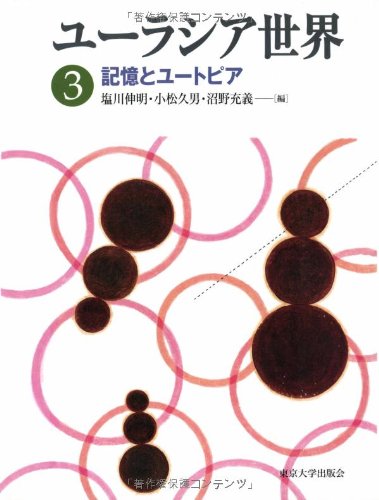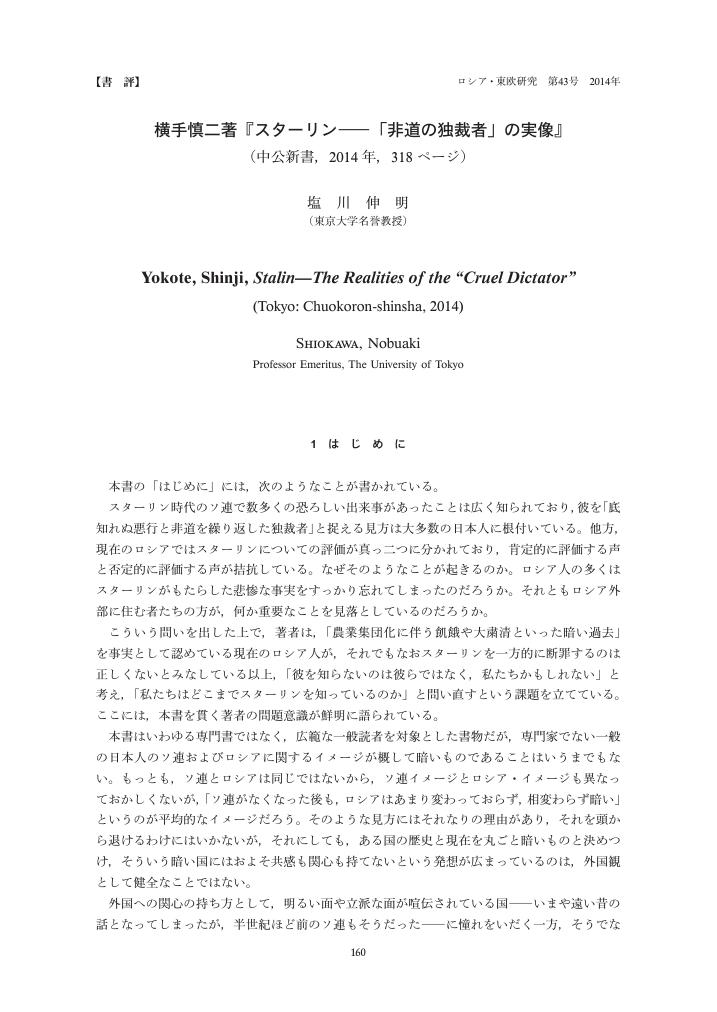273 0 0 0 ボーダレス化時代における法システムの再構築
今年度は、国家と社会、国際化と法、科学技術の発展と法の観点から第2期のまとめを行った。国家と社会に関しては、1.規範定立・執行における社会集団の役割(経済団体による法形成と執行、ドイツ医療保険法におけるFestbetragsfestsetzung制度、トランスナショナル社会運動)、2.市場と国家(政府業務の民間開放と法制度、株式会社・証券市場・市民社会、会社支配市場規制、ボーダレス化時代における租税制度)、3.ボーダレス時代における社会保障・安全確保・司法制度(社会保障法と憲法、警察行政における計画、関係性における暴力とその対応、司法の独立性)、4.国家財産法における公法と私法(政府業務の民間開放、韓国の国家財産法と法政策的課題)をまとめた。国際化と法に関しては、1.境界とは何か(生権力と国家、国境はなぜそしていかに引かれるべきか)、2.境界の変動および意味変容(国際法における境界の位相、国家の統合分裂とシティズンシップ)、3.変容する国際社会と法・政治の対応(パレスチナ問題と国際法、開発・エイズ・人権、経済連携協定、法整備支援)、4.人の国際移動と法・政治の対応(国際移住の法と法政策、民法における外国人問題、国際化と地方自治)をまとめた。科学技術の発展と法に関しては、1.科学技術と生命観(歴史的視座、動物観と法制度設計)、2.科学技術と制度(学問と法システム、リスク評価と法システム、予防原則)、3.科学技術と刑事法(現代型刑罰法規と罪刑法定主義、科学技術の進歩と刑法-過失責任)、4.科学技術と民事法(証券取引の電子化、無体化・電子化と占有概念、5.科学技術と国際法(非国家主体に対する軍備管理、国際環境法における科学技術と対話プロセス)を取りまとめた。なお、とりまとめの過程で2006年1月に国際シンポジウムを開催した。また、第1期の成果5巻も無事出版した。
4 0 0 0 記憶とユートピア
- 著者
- 塩川伸明 小松久男 沼野充義編
- 出版者
- 東京大学出版会
- 巻号頁・発行日
- 2012
3 0 0 0 OA 〈パネルディスカッション〉 歴史の中の体制転換
- 著者
- 塩川 伸明 柴 宜弘 田口 雅弘 望月 哲男
- 出版者
- The Japanese Association for Russian and East European Studies
- 雑誌
- ロシア・東欧研究 (ISSN:13486497)
- 巻号頁・発行日
- vol.2010, no.39, pp.26-56, 2010 (Released:2012-06-20)
3 0 0 0 民族浄化・人道的介入・新しい冷戦 : 冷戦後の国際政治
2 0 0 0 OA 危機管理と政治変容
- 著者
- 藤原 帰一 久保 文明 加藤 淳子 苅部 直 飯田 敬輔 平野 聡 川人 貞史 川出 良枝 田邊 國昭 金井 利之 城山 英明 谷口 将紀 塩川 伸明 高原 明生 大串 和雄 中山 洋平
- 出版者
- 東京大学
- 雑誌
- 基盤研究(A)
- 巻号頁・発行日
- 2012-10-31
危機管理の政策決定と、それが政治社会にもたらす効果について、多角的な実地調査とデータ収集を行うとともに、三つの理論的視点、すなわちセキュリタイゼーション研究、危機管理研究、そして平和構築から分析を進めた。本作業の国際的パートナーがオレ・ウィーバー、イークワン・ヘン、そして、ジョンアイケンベリーであり、この三名を含む内外の研究者と共に2015年1月30日に大規模な国際研究集会を東京にて開催し研究成果の報告を行った。本会議においては理論研究とより具体的国際動向の分析を行う研究者との間の連絡に注意し、実務家との意見交換にも留意した。
2 0 0 0 OA ソ連言語政策史再考
- 著者
- 塩川 伸明
- 出版者
- 北海道大学スラブ研究センター
- 雑誌
- スラヴ研究 (ISSN:05626579)
- 巻号頁・発行日
- vol.46, pp.155-190, 1999
Hitherto, Soviet language policy was often interpreted to be aimed at "Russification." Although this viewpoint is not entirely groundless, it is often exaggerated and tends to lead to a one-sided picture. It is true that many non-Russian nationalities in the Soviet Union have been, more or less, linguistically russified. But it cannot be denied that some nationalities, especially those with Union republics, have retained their national languages to a fairly high degree. Thus, it is necessary to investigate the language situation more fully on the basis of empirical data. It is well-known that in the 1920s the Soviet authorities adopted the policy of "korenizatsiia," which meant extending education among nationalities by their own national languages. For the central political leaders, this policy was merely a means for spreading the official policy to the masses. In the localities, however, some activists tried to use this policy for nationalistic purposes. Thus, the meaning of the policy of "korenizatsiia" was ambivalent and the process of its implementation was not consistent. The 1930s saw several policy changes, but the process of the changes was not so straight-forward as was often supposed. First of all, at the beginning of the decade political centralization was greatly enhanced, and as a result some republican leaders were demoted. This personnel change entailed the strengthening of political control over nationalities. It is important, however, not to confuse this political centralization with Russification, for Russian people also suffered severely by the political control, and the old Russian national tradition was not officially glorified, at least until the mid-1930s. The attitude of the Soviet authorities toward old traditions began changing around the mid-1930s. The fervent anti-traditionalism of the early revolutionary days subsided and the queer amalgam of Sovietism and pre-Revolutionary tradition came into being. This situation made it possible for Russian nationalism to creep into the official ideology. This, however, did not necessarily mean that the policy of Russification was established once and for all. Along with Russian nationalism, Ukrainian, Armenian, Uzbek and some other kinds of nationalism also crept into the official ideology, although it is clear that the latter were relatively low-ranked in comparison with Russian nationalism. The Soviet nationality policy after the late 1930s was characterized by its hierarchical nature. At the top of the hierarchy, needless to say, stood Russians. Some relatively large nationalities, such as Ukrainians and Uzbeks which had their own Union republics, came on the second echelon. Then followed the third-ranked nationalities, such as Tatars and Bashkirs, which had Autonomous republics or Autonomous regions, as contrasted with Union republics. At the bottom of the ladder there were minor ethnic groups which were not officially recognized as separate nationalities. The lower an ethnic group was ranked in the hierarchy, the stronger it underwent the tendency of Russification. In contrast, the relatively high-rank ed nationalities maintained their own national languages, with the only exception of Ukrainians and Belarussians who belong to the Eastern Slavic family and are easily russified without administrative pressure. After Stalin died, Khrushcev took an ambivalent nationality policy. On the one hand, he rehabilitated some "punished peoples" who were deported en masse by Stalin and took several decentralizing measures, which enhanced the autonomy of some nationalities. On the other hand, he advocated the all-out construction of full communism and the complete fusion of nationalities under communism. The 1958-59 education reform abolished the principle of compulsory education in native languages and instead introduced the principle of an optional system, which meant that parents could choose which school to send their children to, i.e., to a national- language school or a Russian- language one. Thereafter, education in national languages has continued to decline and some minorities have tended to lose their national languages. It is clear, then, that some of Soviet language policies were explicitly aimed at extending the education of the Russian language among non-Russian nationalities. Among the most prominent were: the 1938 decision to make it compulsory to teach Russian in non-Russian schools; the 1958-59 education reform referred to above; and the more intensified policy of extending the Russian language after the late-1970s. This, however, does not mean that the aim of these policies was the straightforward Russification. As far as the relatively large nationalities were concerned, education in their own nationality language was maintained and Russian was taught as the second language. In this case the official aim was not simple Russification but the spread of bilingualism. As concerns the smaller nationalities, in contrast, the education in their own national language was impossible to enforce, and therefore the Russification progressed through education in Russian. Thus far, we have surveyed the history of the official Soviet language policy. But the effect of the policy is another matter of discussion. In the Soviet Union, especially under Brezhnev, the official policy was often proclaimed only on paper, and the real situation was left far from the state at which the official ideology aimed. It is necessary, therefore, to investigate the real situation on the basis of empirical data. Although the Soviet statistics and sociological research are poor both quantitatively and qualitatively, it is not impossible to examine this situation which differs greatly from the official ideology. Most of the relatively large nationalities, with a few exceptions, have kept their own national languages as mother tongues. Besides, those languages were used quite extensively in education and publishing. As concerns publishing activities in 1985, the number of items published per population was highest in Estonian, Latvian, Lithuanian, and Georgian. Russian came in at the fifth place and Armenian the sixth. In contrast, Belarusian and Ukrainian came in at the sixteenth and eighteenth, respectively. As for education, Soviet languages were classified into three categories: first, those used extensively both in general and higher education. This category includes not only Russian, but also the three Baltic languages, Georgian and Armenian. The second category , which included the Central Asian languages, Moldovan and Azerbaidzhan, was used widely in general education only. In these national republics higher education was mainly conducted in Russian. Finally, the third category, to which Ukrainian and Belarusian belonged, was scarcely used whether in general or in higher education. Those facts we have examined above clearly indicate that the language situation varies from one nationality to another. What factors, then, explain the variation? We may suppose that at least six factors are related. The first one is the position held by each nationality in the Soviet federal system. As was already noted, the Soviet federal system constituted a unique hierarchy, consisting of Union republics, Autonomous republics, Autonomous regions, Autonomous okruga, and those without national autonomy. This hierarchy was closely related to education policy, and the latter influenced the language situation of each nationality. The second factor is the cultural-ethnic proximity of each nationality to the Russians. In this regard, the two Eastern Slavic nationalities, Ukrainians and Belarusians, are, needless to say, most easily russified. Those nationalities who were converted by the Russians into Orthodox, e.g. Chuvashi, Udmurtians, Mordvins etc., have also been greatly russified. In contrast, the degree of Russification of most Moslem and Turkic nationalities remains generally very low. Thirdly, we have to consider the tradition of literary and scientific works in national languages. The greater tradition a nationality has, the more strongly it tends to cling to its own national languages. The Baltic nationalities and Georgians are clear examples. Fourthly, the degree of urbanization influences the process of Russification. In major cities the language of official administration is usually Russian, and Russification proceeds more intensively than in rural areas. This fact is especially important in the Central Asian republics, where the percentage of rural population remains still high. The fifth factor is the percentage of Russians among the population. Needless to say, in the localities where Russians live in mass, Russification tends to be stronger than other areas. Lastly, we have to consider the degree of diaspora of each nationality. Those nationalities who reside scattered all over the whole Soviet Union tend to be more strongly russified than those who live closely in their home republic. It suffices to mention the contrast between Jews, Tatars, or Armenians, on the one hand, and Georgians and the Baltic nationalities, on the other hand. These six do not exhaust the related factors, but we can surmise that these are among the most important ones. By combining these factors, we can make a typology of the language situation of Soviet nationalities. We hope this typology can serve as a solid stepping stone for further investigation.
2 0 0 0 IR E・H・カーのロシア革命論
- 著者
- 塩川 伸明
- 出版者
- 東京大学社会科学研究所
- 雑誌
- 社會科學研究 (ISSN:03873307)
- 巻号頁・発行日
- vol.67, no.1, pp.25-49, 2016-02-25
特集 ケインズとその時代を読むⅡ
1 0 0 0 OA 横手慎二著『スターリン―「非道の独裁者」の実像』 (中公新書,2014年,318ページ)
- 著者
- 塩川 伸明
- 出版者
- ロシア・東欧学会
- 雑誌
- ロシア・東欧研究 (ISSN:13486497)
- 巻号頁・発行日
- vol.2014, no.43, pp.160-165, 2014 (Released:2016-09-09)
1 0 0 0 OA 体制転換の見取り図 (梗概)
- 著者
- 塩川 伸明
- 出版者
- ロシア・東欧学会
- 雑誌
- ロシア・東欧学会年報 (ISSN:21854645)
- 巻号頁・発行日
- vol.1997, no.26, pp.135-137, 1997 (Released:2010-05-31)
1 0 0 0 IR ソ連言語政策史再考
- 著者
- 塩川 伸明
- 出版者
- 北海道大学スラブ研究センター
- 雑誌
- スラヴ研究 (ISSN:05626579)
- 巻号頁・発行日
- no.46, pp.155-190, 1999
- 被引用文献数
- 1
1 0 0 0 OA 社会主義改革論の挫折 経済学者への問いかけ
- 著者
- 塩川 伸明
- 出版者
- 比較経済体制学会
- 雑誌
- 社会主義経済学会会報 (ISSN:18839789)
- 巻号頁・発行日
- vol.1992, no.30, pp.29-34, 1992-11-30 (Released:2009-07-31)
1 0 0 0 IR E・H・カーのロシア革命論
- 著者
- 塩川 伸明
- 出版者
- 東京大学社会科学研究所
- 雑誌
- 社会科学研究 (ISSN:03873307)
- 巻号頁・発行日
- vol.67, no.1, pp.25-49, 2016
特集 ケインズとその時代を読むⅡ
1 0 0 0 ロシア革命百周年記念討論会
- 著者
- 和田 春樹 塩川 伸明 宇山 智彦 池田 嘉郎 長縄 宣博 松里 公孝
- 出版者
- ロシア史研究会
- 雑誌
- ロシア史研究 = История России (ISSN:03869229)
- 巻号頁・発行日
- no.99, pp.26-61, 2017
- 著者
- 塩川 伸明
- 出版者
- 中部大学総合学術研究院
- 雑誌
- アリーナ (ISSN:13490435)
- 巻号頁・発行日
- no.10, pp.20-29, 2010





